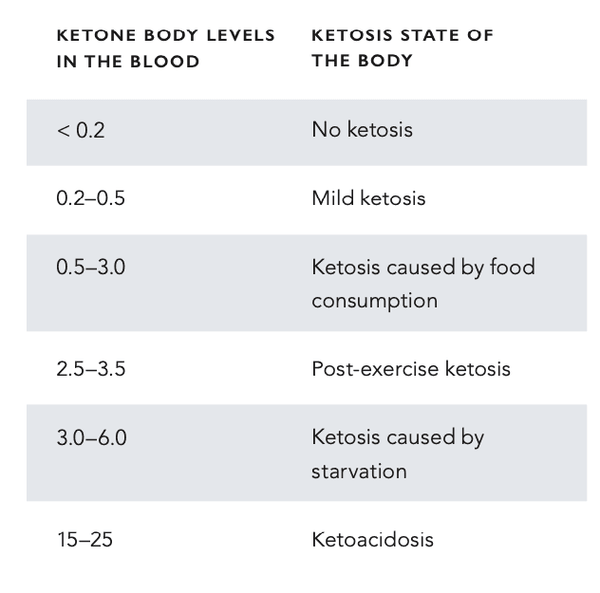Ketosis produces three main ketone bodies: acetone, acetoacetate and beta-hydroxybutyrate. All three ketone bodies can be measured using various methods. The most commonly used method is to check the levels of betahydroxybutyrate (BHB) in the blood. Another popular method is to measure the amount of acetone in the breath. A third method is to measure the acetoacetate levels in the urine. Of these, the BHB levels in the blood are considered the most accurate, particularly for monitoring changes in the ketone body production in the early stages of ketosis.
ALL YOU NEED TO KNOW ABOUT KETOSIS: BIOHACKER'S GUIDE TO KETOSIS.
Measuring is not absolutely necessary. However, it does provide a measurable indication of the activation of ketosis and may give a morale boost to continue with the diet, especially in situations where the motivation is low.
1. MEASURING KETONE BODY LEVELS IN THE BLOOD
Ketone bodies (BHB) in the blood are measured the same way as blood sugar levels, with a finger prick test. A special device can be used to measure both blood sugar and ketone body levels from a drop of blood extracted from the fingertip. The measurements are generally very accurate. The downsides are the high ongoing cost (the test strips cost several euros each) and the constant finger pricking. The price of the device is between 20 and 50 euros. Good quality devices include CareSens Dual Blood Glucose and Ketone Meter and Freestyle Precision NEO Blood Glucose Monitoring Meter. Ketone body test strips for these devices are available, the prices of which vary between 3–4 euros per strip (usually sold in packs of 10).

This testing method is effective especially when starting out with the ketogenic diet and monitoring ketone body levels. Most people reach mild ketosis (0.5–1.0 mmol/L) within a few days and deeper ketosis (1.5–3.0 mmol/L) within 2–4 weeks. The further the progress of keto-adaptation whilst adhering to the ketogenic diet, the more efficient the use of ketone bodies for energy supply. This in turn leads to a dip in the BHB levels in the blood, and often significantly lower readings are seen compared to the first few weeks on the ketogenic diet. This is completely normal.
2. MEASURING KETONE BODY LEVELS IN THE BREATH
If poking your fingers with a needle is not your idea of fun, there are several devices on the market that measure acetone in the breath. Out of all ketone body molecules, acetone is by far the smallest in size and thus excreted via the respiratory system. This in turn makes it possible to measure ketosis by analyzing respiratory gases. Measuring the acetone in the exhaled gases has been found to be an accurate method of assessing ketosis, as long as the test is always repeated in the same way and the device has been carefully calibrated for the air in the room. Acetone levels can also be compared to the BHB levels in the blood.
A study published in 2018 found breath analyzers to be a reliable method of assessing the state of continuous ketosis in healthy individuals adhering to the ketogenic diet, as well as for those suffering with epilepsy. Measuring acetone levels in the breath can also be used for weight management and monitoring fat burning in those adhering to the ketogenic diet.
In the light of this information, breath analyzers are a very good, convenient method for monitoring the ketogenic diet in the long term, particularly when the goal is weight loss or the prevention of epileptic seizures.
The earliest and most widely used acetone meter on the market is the Swedish-made Ketonix, which has been found to be a very effective and reliable device. As a newer measuring device, Acetrack has arrived on the market, which is more stylish and clearer in terms of user interface than Ketonix. Both are equally accurate and based on the same method.
3. MEASURING KETONE BODY LEVELS IN THE URINE
Measuring ketone bodies (more specifically acetoacetate) in the urine has been possible for some time now. It is used especially in healthcare when the urine is checked for glucose, ketone bodies, or protein. However, the ketone bodies in the urine are not so much indicative of ketosis, rather they indicate the level of excess ketone bodies being excreted from the body. Thus, particularly in the early stages of ketosis, the level of ketone bodies in the urine is usually high, as the body has not yet keto-adapted. This method is, of course, useful for monitoring the onset of ketosis. As the keto-adaptation/fat-adaptation progresses, the ketone body levels in the urine usually decrease as the ketone bodies are being efficiently used for energy in the body.
The urine testing is typically used to assess ketoacidosis in diabetic individuals, especially when the finger prick test is not available.
How do you measure your ketosis status? Tell us in the comments and share your own experiences!





